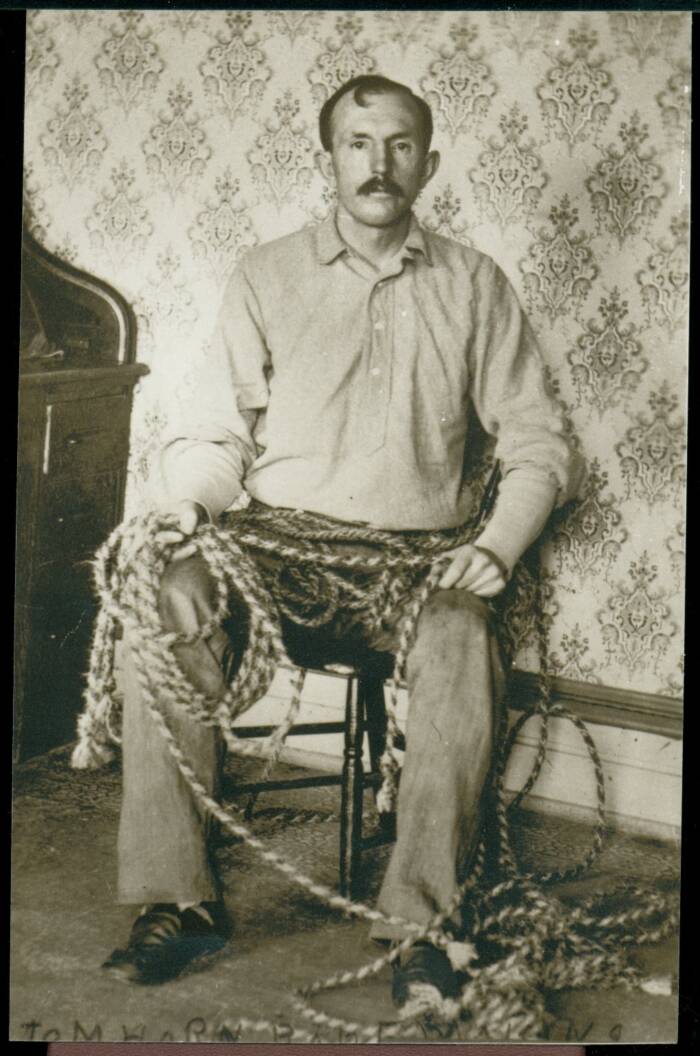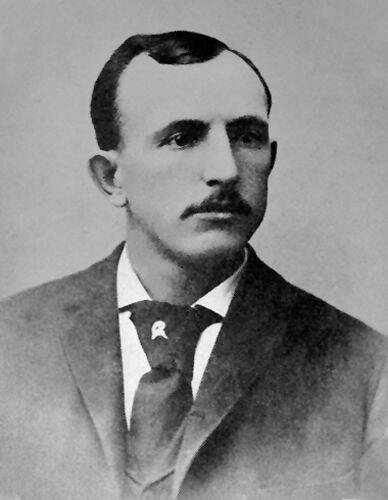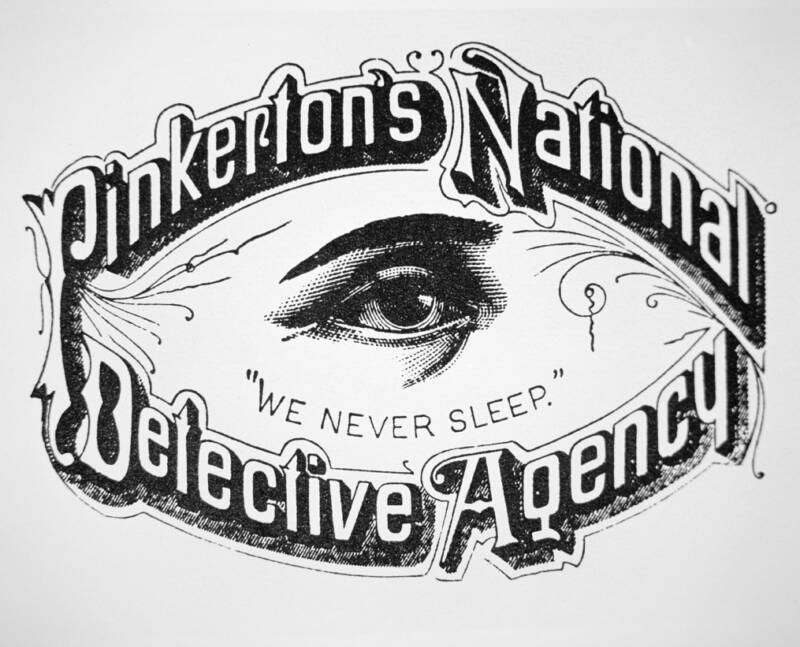Tom Horn was a scout for the U.S. Army, a cowboy, a deputy sheriff, and a private detective for the Pinkerton Agency. But it was his final stint as a hired gun that would lead to his demise.

American Heritage Center, University of WyomingTom Horn was officially a “range detective” but was better known as a gunman for hire in the American Old West.
Picture the old American “Wild West.” Scenes likely come to mind of gun-slinging cowboys and drunken fights in saloons with swinging doors, an image that was perpetuated by Western movies.
But while the real American frontier was certainly a bit tamer than Hollywood made it out to be, some elements of Old West history seem wild enough to be fiction — such as the story of Tom Horn, the U.S. Army scout-turned-private-agent-turned-hitman. Indeed, Horn was notorious for telling tall tales, making it difficult to discern how much of his story was true and how much he made up.
Many historians believe that Tom Horn was responsible for 17 murders across the western United States. But when he was finally convicted in the early 20th century, he was executed for a murder he likely had nothing to do with.
Tom Horn’s Tumultuous Early Years
Thomas Horn Jr. was born in southern Missouri in 1860. The fifth of 12 children, he was frequently physically abused by his father, leading him to run away when he was just 14 years old.
Horn made his way west, joining the U.S. Army as a scout at the age of 16. Recognized for his natural aptitude as an interpreter and tracker, he quickly rose through the ranks. Notably, he was part of the unit responsible for the surrender of Geronimo, the Apache leader during the 19th-century Apache Wars. But while Horn claimed that he played an integral role in this negotiation, he was likely just an interpreter.

Public domainAs a U.S. Army scout, Horn was part of the unit responsible for the surrender of Geronimo.
After the war, Horn continued moving west and took on a variety of odd jobs for a few years, working as a ranch hand and competing in rodeo competitions. He even won a steer-roping contest in Globe, Arizona in July 1888, setting a new world record time.
For a short period, Horn owned a ranch in Aravaipa Canyon, Arizona. But soon after he purchased it, cattle thieves reportedly stole all of his stock in the middle of the night. Horn went bankrupt, and the robbery reportedly led him to a pursue a career in law enforcement. He had a brief stint working as a deputy sheriff in Arizona before he was recruited by the infamous Pinkerton National Detective Agency.
The Shadowy World Of Private Security
In 1890, Tom Horn signed on with the Pinkerton Agency to handle their investigations in the Rocky Mountains. He essentially worked to track down and apprehend Wild West outlaws — often through violent means.
The Pinkerton Agency was founded in 1850 as a private detective and security agency, initially focussed on protecting railroads from the scourge of train robberies at the time. The original Pinkerton building in Chicago featured a logo of a black-and-white eye above the motto “We never sleep.” This logo inspired the term “private eye.”
Prior to the founding of the FBI in 1908, government entities and officials often hired private investigators to perform the services now carried out by government agencies like the FBI and CIA. In 1861, for example, Pinkerton agents foiled an assassination plot against then-president elect Abraham Lincoln. Lincoln also hired Pinkerton agents as private security during the Civil War.
As such, Pinkerton was the first legitimate private detective agency in the nation, and business boomed in the latter part of the 19th century. Detectives were hired to catch high-profile outlaws like Jesse James, the Reno Brothers, and Butch Cassidy and the Sundance Kid. By the 1870s, Pinkerton had the world’s largest collection of mugshots and a first-of-its-kind criminal database. At its peak, it had more agents than the standing army of the United States.

Public DomainThe Pinkerton logo was the inspiration for the term “private eye.”
Tom Horn And The Pinkerton Agency
Being an agent of a quasi-government group didn’t stop men like Tom Horn from committing crimes in the name of seeing justice done.
“Rumors persisted that detectives secretly worked on both sides of the same case, kidnapped witnesses, bribed juries, [and] commonly used violence to break strikes and coerce confessions,” wrote Frank Richard Prassel in The Western Peace Officer: A Legacy of Law and Order, according to the American Heritage Center.
Horn denied killing anyone under the orders of the Pinkerton Agency, although he was suspected of several murders during his stint there. Pinkerton reportedly forced Horn to resign in 1894.
“William A. Pinkerton told me that Tom Horn was guilty of the crime, but that his people could not let him go to prison while in their employ,” Pinkerton detective Charlie Siringo wrote in his memoir Two Evil Isms: Pinkertonism and Anarchism, as reported in Melody Groves’ book When Outlaws Wore Badges.
Cattle Thief And Assassin-For-Hire
After Tom Horn left the Pinkerton Agency, he worked as a freelance range detective (read: hitman) for various cattle companies in northern Colorado and Wyoming.
The cattle companies took issue with the homesteaders moving to the area under the Homestead Act of 1862, which allowed American citizens to move onto unclaimed land surveyed by the U.S. government and cultivate it. Cattle ranchers viewed the settlers as encroaching on their land and often hired private detectives to scare the homesteaders off — or, as was often the case with Tom Horn, to kill them.

American Heritage Center, University of WyomingTom Horn went from working in law enforcement to being an outlaw himself.
Additionally, the cattle industry, which had been booming just a decade earlier, was in a spiraling decline. After cattle prices peaked in 1882, ranchers were the richest they had ever been, but they erroneously bought more cattle and stocked their ranches with more livestock than the land could support. This led to an oversupply of beef, which sank profits. The industry continued to free fall after a bad drought and a brutal winter in 1886.
Cattle ranchers blamed their problems on everyone and everything except their own poor business decisions, attacking homesteaders and blaming cattle thieves, also known as rustlers. Ranchers often complained that the courts were refusing to punish rustlers, leaving them to take matters into their own hands.
“It is very difficult to get an indictment from a grand jury [even] with pretty definite evidence as to the guilt of the party charged with stealing cattle,” said Wyoming Stock Growers Association secretary Thomas Sturgis in 1886, according to the Wyoming Historical Society. “There seems to be a morbid sympathy with cattle thieves both on the bench and in the jury room… Circumstances have forced cattlemen to look to themselves for protection outside of any association.”
That’s where Tom Horn came in. Already a talented tracker, Horn was known for his ability to shoot targets from 200 yards away. It’s believed he killed as many as 17 people as a range detective.
He was also known for his habit of drunkenly boasting about his many adventures, sometimes exaggerating or even making them up. And it’s this penchant for telling tall tales that would eventually get Horn into trouble.
The Murder Of Willie Nickell
On July 18, 1901, 14-year-old Willie Nickell, the son of a Wyoming sheep rancher, was found dead outside of his family’s homestead. He had been shot twice from a long range.
There were no witnesses to the brutal murder, nor was there any hard evidence. Some suspected that Tom Horn may be responsible, suggesting that the notorious hitman may have been hired to kill the boy’s father but, mistaking Willie for the older man, shot the boy instead.

Public DomainIt is believed that Tom Horn was responsible for as many as 17 murders.
U.S. Deputy Marshal Joe LeFors was tasked with investigating the murder. He had been told by his boss that he would get a promotion if he found Willie’s killer.
“At the time the feeling was running high and the demand was for justice,” LeFors wrote in his autobiography, according to Cowboys & Indians Magazine. “I knew those Cheyenne politicians were for politics first and justice next.”
LeFors suspected Horn due to his violent reputation and decided to stage a trap. He reached out to Horn, inviting him to interview for a fake job in Montana.
Horn, who was reportedly drunk during the interview, readily confessed to killing Willie Nickell.
“Killing men is my specialty,” he said proudly, bragging that he had shot Willie from 300 yards away. “It was the best shot that I ever made and the dirtiest trick I ever done.”
But little did Horn know, a court stenographer was secretly transcribing their conversation in the next room over. Horn was swiftly arrested and charged with the murder of Willie Nickell.
The Death Of Tom Horn

Public DomainTom Horn was hanged for the murder of Willie Nickell, though some historians say he may have been innocent.
After his arrest, Tom Horn retracted his confession, claiming he’d just been “joshing” and that he was innocent.
Indeed, there was no material evidence tying Horn to the crime. In fact, during his trial, one witness account actually placed him far from the crime scene.
Still, Horn was convicted solely on the basis of his drunken confession.
Tom Horn was hanged in Cheyenne, Wyoming, on Nov. 20, 1903, bringing his wild ride to an end. To this day, many historians have questioned whether he really committed the murder of Willie Nickell, noting that his conviction was based on a dubious confession.
Still, there’s no denying that Horn had likely gotten away with several other murders, even if he wasn’t guilty of the one he was actually convicted of. Today, his legacy stands as one of the Old West’s most infamous cowboys. As he said before his trail:
“If I get killed now I have the satisfaction of knowing I have lived about 15 ordinary lives.”
After reading about the life and crimes of Tom Horn, see what life on the American frontier was really like by perusing these photos of Wild West saloons. Then, learn about the death of another infamous outlaw, Billy the Kid.





